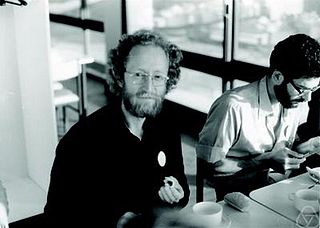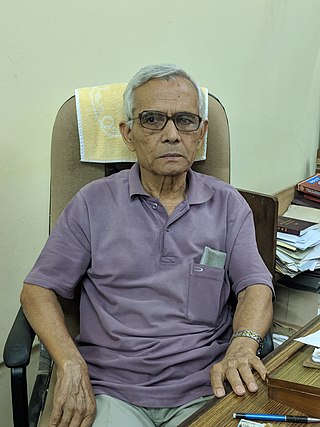
Chaos theory is an interdisciplinary area of scientific study and branch of mathematics focused on underlying patterns and deterministic laws of dynamical systems that are highly sensitive to initial conditions, and were once thought to have completely random states of disorder and irregularities. Chaos theory states that within the apparent randomness of chaotic complex systems, there are underlying patterns, interconnection, constant feedback loops, repetition, self-similarity, fractals, and self-organization. The butterfly effect, an underlying principle of chaos, describes how a small change in one state of a deterministic nonlinear system can result in large differences in a later state. A metaphor for this behavior is that a butterfly flapping its wings in Texas can cause a tornado in Brazil.

In physics and chemistry, an equation of state is a thermodynamic equation relating state variables, which describe the state of matter under a given set of physical conditions, such as pressure, volume, temperature, or internal energy. Most modern equations of state are formulated in the Helmholtz free energy. Equations of state are useful in describing the properties of pure substances and mixtures in liquids, gases, and solid states as well as the state of matter in the interior of stars.
Monte Carlo methods, or Monte Carlo experiments, are a broad class of computational algorithms that rely on repeated random sampling to obtain numerical results. The underlying concept is to use randomness to solve problems that might be deterministic in principle. They are often used in physical and mathematical problems and are most useful when it is difficult or impossible to use other approaches. Monte Carlo methods are mainly used in three problem classes: optimization, numerical integration, and generating draws from a probability distribution.

In molecular physics, the van der Waals force is a distance-dependent interaction between atoms or molecules. Unlike ionic or covalent bonds, these attractions do not result from a chemical electronic bond; they are comparatively weak and therefore more susceptible to disturbance. The van der Waals force quickly vanishes at longer distances between interacting molecules.

In mathematics, specifically bifurcation theory, the Feigenbaum constants are two mathematical constants which both express ratios in a bifurcation diagram for a non-linear map. They are named after the physicist Mitchell J. Feigenbaum.
Physical Review is a peer-reviewed scientific journal established in 1893 by Edward Nichols. It publishes original research as well as scientific and literature reviews on all aspects of physics. It is published by the American Physical Society (APS). The journal is in its third series, and is split in several sub-journals each covering a particular field of physics. It has a sister journal, Physical Review Letters, which publishes shorter articles of broader interest.
In physics, Landau damping, named after its discoverer, Soviet physicist Lev Davidovich Landau (1908–68), is the effect of damping of longitudinal space charge waves in plasma or a similar environment. This phenomenon prevents an instability from developing, and creates a region of stability in the parameter space. It was later argued by Donald Lynden-Bell that a similar phenomenon was occurring in galactic dynamics, where the gas of electrons interacting by electrostatic forces is replaced by a "gas of stars" interacting by gravitational forces. Landau damping can be manipulated exactly in numerical simulations such as particle-in-cell simulation. It was proved to exist experimentally by Malmberg and Wharton in 1964, almost two decades after its prediction by Landau in 1946.
In physics and engineering, a constitutive equation or constitutive relation is a relation between two physical quantities that is specific to a material or substance, and approximates the response of that material to external stimuli, usually as applied fields or forces. They are combined with other equations governing physical laws to solve physical problems; for example in fluid mechanics the flow of a fluid in a pipe, in solid state physics the response of a crystal to an electric field, or in structural analysis, the connection between applied stresses or loads to strains or deformations.

Mitchell Jay Feigenbaum was an American mathematical physicist whose pioneering studies in chaos theory led to the discovery of the Feigenbaum constants.

Ryogo Kubo was a Japanese mathematical physicist, best known for his works in statistical physics and non-equilibrium statistical mechanics.
In the study of dynamical systems the term Feigenbaum function has been used to describe two different functions introduced by the physicist Mitchell Feigenbaum:
Brosl Hasslacher was a theoretical physicist.

The viscosity of a fluid is a measure of its resistance to deformation at a given rate. For liquids, it corresponds to the informal concept of "thickness": for example, syrup has a higher viscosity than water. Viscosity is defined scientifically as a force multiplied by a time divided by an area. Thus its SI units are newton-seconds per square metre, or pascal-seconds.

Oscar Erasmus Lanford III was an American mathematician working on mathematical physics and dynamical systems theory.

Padma Kant Shukla was a distinguished Professor and first International Chair of the Physics and Astronomy Department of Ruhr-University Bochum in Germany. He was also the director of the International Centre for Advanced Studies in Physical Sciences at Ruhr-University Bochum. He held a PhD in physics from Banaras Hindu University in Varanasi, India and a second doctorate in Theoretical Plasma Physics from Umeå University in Sweden.

Antonio Castellanos Mata was a Spanish physicist.
Rahul Pandit is an Indian condensed matter physicist, a professor of physics and a divisional chair at the Indian Institute of Science. Known for his research on phase transitions and spatiotemporal chaos and turbulence, Pandit is an elected fellow of Indian Academy of Sciences, Indian National Science Academy and The World Academy of Sciences. The Council of Scientific and Industrial Research, the apex agency of the Government of India for scientific research, awarded him the Shanti Swarup Bhatnagar Prize for Science and Technology, one of the highest Indian science awards, for his contributions to physical sciences in 2001.
Howard Theodore "Ted" Davis (1937–2009) was an American chemical engineer and regents professor in the Department of chemical engineering and materials science (CEMS) at the University of Minnesota. He is internationally known for his work in statistical thermodynamics, transport in porous media, and surface thermodynamics. Davis was an author of more than 400 academic papers and five books including the acclaimed textbooks: “Linear Algebra and Linear Operators in Engineering” ., "Statistical Mechanics of Phases, Interfaces and Thin Films". He served as the department head of CEMS for 15 years (1980-1995), followed by his leadership as dean (1995-2005) of the Institute of Technology, the University of Minnesota's college of physical science and engineering. In 2008, Davis became the director of the University of Minnesota's BioTechnology Institute

Yashwant Singh is an Indian theoretical physicist known for his contributions to soft matter physics. He is at present Distinguished Professor and INSA Senior Scientist at Banaras Hindu University.
Statistical associating fluid theory (SAFT) is a chemical theory, based on perturbation theory, that uses statistical thermodynamics to explain how complex fluids and fluid mixtures form associations through hydrogen bonds. Widely used in industry and academia, it has become a standard approach for describing complex mixtures. Since it was first proposed in 1990, SAFT has been used in a large number of molecular-based equation of state models for describing the Helmholtz energy contribution due to association.










